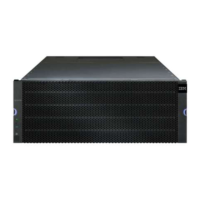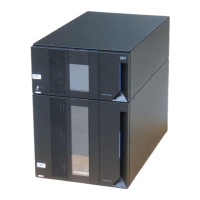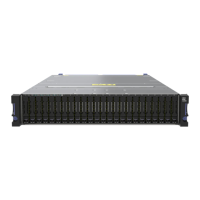3. On the primary storage subsystem – The utility suspends the mirrored pairs for all of the
participating volumes. This action causes updates to stop on the secondary side, leaving the
secondary volumes in a recoverable state because they were being updated in Synchronous mode
immediately before the suspension. By separating the mirrors in this manner, the primary-side
applications run faster, while leaving the secondary volumes in a recoverable state. The delta log
tracks changes made because of application writes on the primary side while in this state.
4. On the secondary storage subsystem – The utility generates a FlashCopy of each participating
volume on the secondary side, which creates point-in-time images that are recoverable.
5. On the primary storage subsystem – The utility resumes the mirroring operations for all of the
participating volumes. This action causes the mirrors to migrate to the Synchronized state and start
the process of restoring coherency between the primary site and the secondary site.
6. On the primary storage subsystem – The utility reconfigures all of the affected volumes for Global
Copy mode.
Running the Enhanced Remote Mirroring Utility
The Global Copy Mirror utility uses a command line argument that enables you to specify the name of a
configuration file. The configuration file contains a complete specification of the input parameters that are
needed by the utility. To run the utility, enter this syntax:
asyncRVMUtil configuration_file -d debug_file
In this command, configuration_file is the file that you provide as input. The configuration file
specifies the Enhanced Remote Mirroring volumes that you want to synchronize by using the utility.
When you create the configuration file, use these conditions to define the volumes in the file:
v All the primary volumes in a volume set must belong to the same storage subsystem.
v The maximum number of volume sets that you can specify in the file is four.
v The maximum number of mirrored pairs that you can specify as part of a consistency group is eight.
The optional parameter, -d, lets you specify a file to which you can send information regarding how the
utility runs. In this example, the file name is debug_file. The debug file contains trace information that
can be reviewed by your Technical Support representative to determine how well the Global Copy Mirror
utility has run.
Note: Depending on the location of the configuration file and the debug file, you must specify the
complete path with the file name.
To run the Global Copy Mirror utility, you must enter the asyncRVMUtil command from the command
line. Because UNIX operating systems are case sensitive, you must type the command exactly as shown.
On Windows operating systems, you can type the command in all uppercase, in all lowercase, or in
mixed case.
Note: To use the Global Copy Mirror utility, you must be managing the storage subsystem by using the
command line interface, not the graphical user interface of IBM DS Storage Manager 10.
Configuration utility
The configuration file is an ASCII flat text file that provides the information for the Enhanced Remote
Mirroring synchronization used by the Global Copy Mirror utility. The file defines the mirror volume sets
to be synchronized. All of the mirror volumes in the volume sets defined in the configuration file are run
collectively to create a recoverable image. If any one of the mirrors in the volume set fails, the operation
is stopped for this volume set and carried on to the next volume set that is listed in the configuration file.
The configuration file supports this syntax:
C-2 IBM System Storage DS3000, DS4000, and DS5000: Command Line Interface and Script Commands Programming Guide

